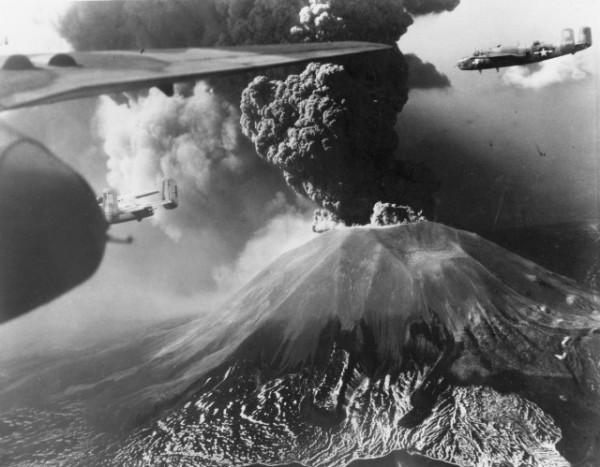March 20, 1944
As I sit in my tent just off the runway of the Pompeii Airdrome, which is situated a few miles from the foot of Mt. Vesuvius, I can hear at four to ten second intervals the loud rumbling of the volcano on the third day of its present eruption. The noise is like that of bowling balls slapping into the pins on a giant bowling alley. To look above the mountain tonight, one would think that the world was on fire. The thickly clouded sky glows like that above a huge forest fire. Glowing brighter as new spouts of flame and lava are spewn from the crater. As the clouds pass from across the top of the mountain, the flame and lava can be seen shooting high into the sky to spill over the sides and run in red streams down the slopes.
 Last night was much clearer, but the volcano seemed not as angry as it does tonight. Against the darkness of the night the lava gave fiery edges to each side of the crater and part way down the slopes. The rumblings started sometime yesterday and have continued at a few seconds intervals ever since. The lava started spilling over three days ago. Today it is estimated that a path of molten lava one mile long, a quarter mile wide, and eight feet deep is rolling down the mountain.Towns on the slopes are preparing to evacuate.
Last night was much clearer, but the volcano seemed not as angry as it does tonight. Against the darkness of the night the lava gave fiery edges to each side of the crater and part way down the slopes. The rumblings started sometime yesterday and have continued at a few seconds intervals ever since. The lava started spilling over three days ago. Today it is estimated that a path of molten lava one mile long, a quarter mile wide, and eight feet deep is rolling down the mountain.Towns on the slopes are preparing to evacuate.
Have just looked at the mountain through high-powered glasses. It is some sight. Flame, sparks and lava are being thrown from the crater like rice at a wedding. Going high and spilling out on all sides. The rumblings are now growing louder and the flame and sparks are flying higher. — The mountain is really angry tonight. This is a sight to be remembered. An ironically beautiful sight. The dark clouds against the red glow with bursts of flame showing between from time to time is quite a picture.
Our location is, apparently, safe. At any rate no one here, civilian or Army Authorities, seem too much worried. Lava has not started to flow down this side of the mountain as yet but is flowing on the other side towards Naples. I can imagine that the people in that vicinity are highly apprehensive.
This is a feeble description. Would that I had words to really describe this occasion.
March 21, 1944
This was a rainy day, heavy clouds hung over the mountain so that its activity could not be observed. However, the rumblings and explosions gave evidence that the fury had not abated. Towards evening the rain stopped and the clouds cleared away to reveal dense smoke and heavy steam pouring upwards to many thousand feet and spreading out over an area of many square miles. The dense, billowy steam took beautiful forms lighted around the edges by the increasing sunshine. At about 5:30 P.M. small streams of lava began running down our side of the mountain. The first on this side. Soon many swift, fiery streams were flowing in all directions. The rumbling continues. – More prolonged now. This evening it would seem that the whole top of the mountain is burning. Fiery patches here and there resemble a log which is just burning out. Heavy explosions occur followed by prolonged rumbling while sparks and molten lava are thrown high into the air to fall like rain on all sides of the cone.
The mountain is hard to describe. The eruptions occur from a cone which sets apart and inside the rest of the mountain, rising many feet above the mountain proper. There is a gully around the cone. Above the gully sparks are falling and fiery streams are flowing. Below the gully lies snow which has fallen
during the day. Much of the rest of the mountain is covered with snow. A most interesting contrast. – Dark clouds hang heavy above Vesuvius tonight but they are penetrated by the red glow. —— At 11 P.M. 1 A.M. scheduled for guard duty on the airfield. The tour will end at 5 A.M. This should be an interesting tour. I shall write tomorrow about the occurrences during the night. – We are a bit concerned about the whole thing and I imagine that many soldiers have offered, as I have, a prayer for safety.
March 29, 1944
Eight days since my last entry. A lot has happened. The end is not yet. I should like to report from the present and work back but for the sake of interest shall try to take up where I left off. The early part of my guard tour was more or less uneventful. Low storm clouds made the night very black. The mountain although invisible could be heard. Rumblings and explosions continued. Occasionally fine black particles fell like rain. From time to time the clouds would lift to partially reveal the volcano’s cone. It was an eerie sight. It appeared as tho’ glowing lava was flowing through the clouds. Now and then the top was visible to reveal flame and lava shooting skyward.
At about 1:15 A.M. the mountain began to pant like a mighty giant gasping for breath. This continued for about a half hour and was followed by a continued deep rumbling. A huge black cloud in the exact shape of a great reclining bear completely hid the mountain so that its activity could not be observed. With the rumbling more of the fine black particles began to fall.
At 2 A.M. the volcano seemed to explode, mighty roaring occurred and pieces of lava as large as golf balls began to fall around me – ten miles from the foot of the mountain. They beat upon the planes setting up a racket in the black of that eventful night like hail on tin roofs. This continued for about ten or fifteen minutes. Then the mountain became quiet to remain still until about 3 A.M. when the huffing, puffing and rumbling was repeated but in greater intensity. At 4 A.M. the stones (lava) began to fall again and continued for about twenty-five minutes, —– from 5 A.M. to 6 A.M. the same procedure was repeated. At 8 A.M. all hell broke loose. Black stones of all sizes, some as large as a football, fell in great quantity completely covering the ground, breaking branches from the trees, smashing through the tents to break up on their floors, tearing through metal, fabric and Plexiglas of the airplanes. Soon all the tents were in tatters with much of their contents destroyed by direct hits. Radios, cots and many other effects were severely damaged. The storm of lava and rain continued through the morning piling up on the ground like snow and multiplying the damage. Soldiers who ventured from shelter wore steel helmets. Civilians covered their heads with pans, boxes or heavy baskets.
At about noon – March 22nd, it was decided to evacuate the entire camp. All personal belongings were gathered and amid much confusion my truck finally got off at 3 P.M. The storm still raged. Small stones fell in quantity and every fifteen minutes or so the heavens would open up with the big stuff. I say heavens instead of mountain because that is the way it seemed. The stones were not lobed from the mountain but dropped from the clouds falling straight down with great force. As the clouds thinned out the rocks fell from them as their weight became too great to be supported. Large stones fell close to the mountain till a great distance fine black dust was falling.
About 1 A.M. on the 23rd after having become lost several times we arrived at our new quarters. A tobacco warehouse on the airfield occupied by the 321st Bomb Group at Paestum; near Salerno. We unloaded our things and set up cots under the drying tobacco leaves. A colder night I never experienced and hope never to experience again. The next night was not quite so bad as I slept with all my clothes on, including a leather fur-lined cap with ear flaps pulled down. Upon arising I had only to put on my shoes to be completely dressed.
After breakfast on the 25th, twenty of us were assigned to return to Poggiomarino (Pompeii Airport) to salvage what we could from the damaged aircraft.
April 16, 1944
Upon reaching the airport on the 26th we found almost complete devastation. Tents were torn to ribbons and 88 airplanes were a total loss. 88 B-25 Mitchells — $25,000,000 worth of aircraft. How Jerry gloated. Axis Sally dedicated her program one evening to the survivors of the 340th Bomb Group. Actually a sprained wrist and a few minor cuts were the only casualties. The following night she cracked “W got the Colonel,Vesuvius got the rest.” [The Group commander Colonel Charles D. Jones was shot down over Littorio on March 10, 1944 and became a POW for the duration.] She explained how the 340th was no longer operational. How wrong she was. Within a week the 340th was again bombing Jerry in Northern Italy. We have bombed them every day since. Each of the four Squadrons now (April 15, 1944) has fifteen or more of the finest bombers ever produced. Many of our B-25′s now carry thirteen 50-cal. machine guns. In a few days we will move to Corsica to lead all B-25 Groups in the approaching big show.
Just a few words about Vesuvius and the vicinity as we found it upon our return. At Poggiomarino the lava had completely covered the ground to a depth of at least two feet. From the mountain dense smoke and a brown ash billowed profusely. We were unlucky enough to be windward of the mountain so that the dust got into our eyes and covered our clothing. – Most uncomfortable. After the dust a fine white ash fell completely covering the country side with a snowy whiteness.
As we left the place a week later dense smoke was still billowing from the volcano. The mountain had become quiet and all danger of further eruption seemed to have passed.
So on April 15, 1944 twenty-five days after the disaster the 340th Bomb Group is again a complete fighting unit and still the best damned group there is. Hitler the self-styled “Great Rebuilder” please note.
Read the original diary and explore more about the 1944 eruption of Mount Vesuvius.
Comment |

 Share on Facebook
Share on Facebook
 Tweet
Tweet
 Add My Story
Add My Story






